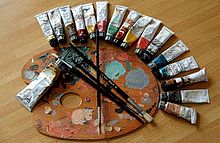Painting
Painting is using colors to make visual art. It is also the word for a painted work of art. Many kinds of paints are used to create art. They include watercolors, acrylics and oils. Other artists like working with pencil or chalk. Sometimes charcoal can be used.[1]


Famous paintings are often kept in art galleries, like the National Gallery in London and the Louvre (Paris) where one of the most famous paintings in the world hangs, the Mona Lisa, painted by Leonardo da Vinci. People do not have to go to a famous gallery to view art. There are private art galleries in many cities around the world.[2]
There is a basic difference between drawing and painting. In drawing, a single layer is the entire image. In painting, one layer is painted over another to get the final image. As a result, most of the time the image will not be clear until it gets to the final stage.
There are four basic stages in painting: preparation, divide, layer, and touch up.
- Preparation: most artists prepare a canvas or other surface. A thin and uniform cover or "wash" of white or other color is laid on the whole surface. This may help the later layers to get the same fix all over the surface. Also, the unseen wash may help the reflection of light from the surface, thus improving the effect for the viewer. For really uneven or colored surfaces, such as wood or rough canvas, a more substantial covering is needed. That is called gesso, traditionally a mixture of chalk and gelatin, but nowadays available as a thick white acrylic. Painting on some surfaces requires a special technique. Painting on plaster uses the fresco method.
- In the divide stage, the canvas is divided into a few major areas (depending on the image you paint), and background for those areas are plotted.
- In the layer stage, a layer is plotted over another layer, to get the desired shape in each area. By the end of this stage, all objects in the image will be easily and clearly identifiable.
- The touch-up stage needs extra effort. This stage is to provide an extra look to the image, like precise bordering, merging layers and other visual effects.
References
change- ↑ "Definition of PAINT". www.merriam-webster.com. Retrieved 2021-05-07.
- ↑ Johann Wolfgang von Goethe. Goethe's theory of colours. Oxford University. J. Murray, 1840.